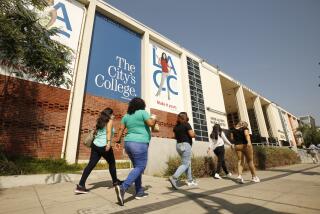Junior College Wake-Up
Los Angeles’ nine community colleges are the cornerstones of the city’s campaign to train welfare recipients for work; they are the Everyman route to higher education. These institutions also provide trained workers to booming industries like computer hardware manufacturing. But because of a crisis in leadership and funding that has prompted two state audits, Los Angeles has been educationally shortchanged by the district, the nation’s largest. Finally, some urgent corrections are being made, and there need to be more.
The crisis came to a head late last year when district leaders granted double-digit pay raises to faculty and staff members, then suddenly announced that the district was facing a $13-million deficit they had no idea how to close.
The immediate fiscal crisis seems to be easing. Having pared the deficit down considerably, the district’s newly installed board president, Elizabeth Garfield, has announced a number of sensible reforms aimed at freeing each community college president to compete within the L.A. district and outside it. Garfield and her fellow board members say they will grant the presidents full autonomy over their budgets so they can decide which, if any, services they want the central district office to provide and so they can retain surplus revenues at year’s end. Under the current system, colleges pay a mandatory tithe to the district’s office and hand over surplus revenues to the colleges that perform less well.
Still, Garfield has yet to make the one change that’s key to the district’s long-term survival: offering the classes students need at the times they need them. That ought to be the basic job of any college, but in the L.A. district many faculty members refuse to teach classes at hours distasteful to them (like 8 a.m.) but highly convenient for working students. Similarly, college presidents who suggest eliminating courses unpopular with students are battered by faculty protests.
Last fall, state law began requiring community colleges to divulge their “completion rates,” the percentages of students who actually complete course programs. These completion rates should be used by the board to identify and overhaul poorly performing programs. The faculty’s reluctance to respond to their students’ needs is at the heart of the present crisis because the district’s state funding is tied to the numbers of enrolled students. Since the early ‘90s that number has been declining. But board members have historically been weak-kneed because faculty contributions fund their election campaigns.
Last month, the district’s faculty and staff unions flatly refused to reopen contract talks. Unless the faculty and staff accept more accountability soon, state officials should hasten change by tying future funding not just to numbers of students but to completion rates and other measures indicating that students are getting what they need to succeed.
More to Read
Sign up for Essential California
The most important California stories and recommendations in your inbox every morning.
You may occasionally receive promotional content from the Los Angeles Times.










